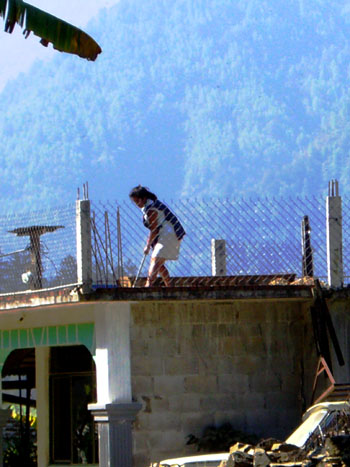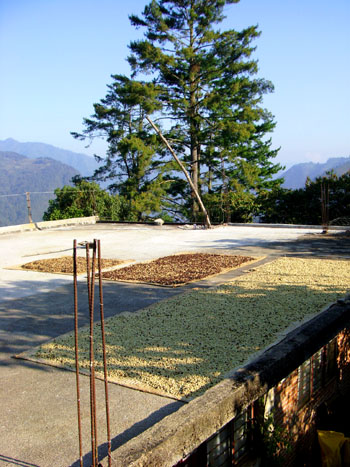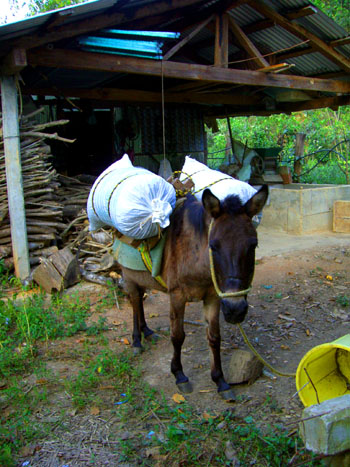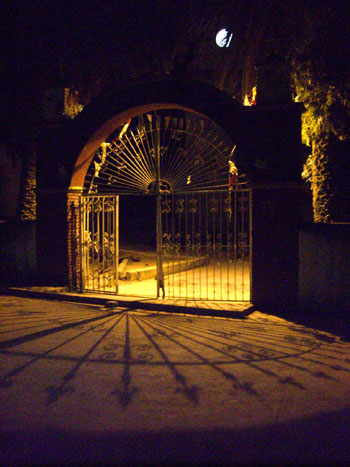
poster outside Tanetze home – foto by smith
the indigenous Zapotec couple we stayed with 3 nights in the mountain-side coffee village of Tanetze (population 2,000) work a lot. they slept in to accommodate us and got up at 7. worked 2 hours. ate hour breakfast. walked down the mountain carrying heavy things. picked coffee beans from trees for 5 hours. hour lunch. 2 hours picking. back up mountain carrying heavy things. work 3 hours. eat light supper. socialize. sleep. start over. 7 days a week. most every day of the year. without us as guests, they probably get up at 5, put in at least 2 more hours of work.
Tomas said, “work work work all the time. we’re crazy.” yet he’s constantly whistling (sometimes i swear double notes), singing, humming, laughing, or shouting “Estabon!” that’s me (estabon = steven). i couldn’t understand a tenth of what he said, yet he wouldn’t stop talking to me, asking me questions, forcing me to follow with hand gestures and vocal mimicry. he made my mind feel slug slow, gave me incentive to study spanish harder. i need to be able to communicate ideas with someone that alive.
Elvira & Tomas are delightful people – gracious, friendly, generous, open, funny, alive . . . and in really good condition. strong too. Elvira is a head shorter than Lady’s five foot five, yet she pulled tree tops down for Lady to pick, and she carried weight up and down the hill that plain tuckered me out when i carried them for her.

neighbor woman working coffee on her roof – foto by smith
while Tomas works the coffee beans on the roof, Elvira fires up the tradition wood burning concrete oven. it’s a large thick hollow slab of concrete with a hole in the side to add wood and declivities on top to hold clay pots to heat coffee, soup, etcetera. there’s also a two foot diameter metal circle called a Comal to cook tortillas and such – about the size and thickness of an oil barrel lid. it’s been used for thousands of years. concrete’s been around for 7,000 years, and folks been living here since before the pyramids. at least since 3,500 BC.
while we pick coffee beans, Elvira starts lunch on the concrete stove down at the coffee plot. she makes soups and stews and such in clay pots that cook for hours while she picks.

coffee tree with ripe red beans – foto by smith
it’s not difficult to pick coffee. pick all the beans that aren’t green. sometimes you can strip a whole branch into your bucket, sometimes you have to pick one at a time. often the branches bow down before you, other times you have to bend the tree down, holding it with one hand, picking with the other. the hard part is doing it for 8 or 10 hours while standing on the uneven side of a steep mountain. we probably picked one bucket for every 5-10 of theirs. they didn’t invite us for our help – more for sharing experience.

coffee beans on roof, in various stages of drying – foto by smith
picked coffee beans are bagged. carried up mountain on 2 horses. soaked in bag. run through a husk cracker. soaked longer. washed. taken up to roof. spread out, worked with blunt wood to break outer shell. bagged over night. each morning he re-spreads various stages of coffee beans to dry on roof on mats. pick day one, dry day two, dry day three, re-bagged each night. heavy bags, 75 – 100 pounds or more. there may be steps or stages i missed.

one day’s picking – foto by smith
basically if Tomas isn’t sleeping, eating, doing maintenance, cutting undergrowth with a machete, or picking coffee, he’s working the coffee in various stages on the roof. what a roof. the village hangs off the side of a mountain, and their house is the last house down. so you stand on the roof and look down down down the mountain to the valley and up to the mountain across from you, or the mountain to your left, or right, or the ones beyond those. wild banana trees everywhere.
end of first day, Lady and i were so tired we went to bed at 8. skipped supper. next morning they said we didn’t have to work if we hurt too much. before we started back down the mountain, my left lens fell out of my glasses, along with the screw. . i need glasses to see both near and far clearly. i found both. fixed. Elvira was going to carry a gunny sack almost as big as she was down the mountain using the traditional head strap. i said i’d carry it for her. couldn’t believe how heavy it was, more than 50 pounds. wasn’t sure i could make it down the mountain. on the worst of the path, we startled a campesino. he couldn’t believe a gringo was carrying Zapotec weight down the mountain the Zapotec way. he said “you be careful.” made it down, told lady no way could i carry anything back up.
at the end of the day, Elvira tied the head strap to a 40 pound basket. i couldn’t bear to see her carry it up the mountain, so i took it. going up the steepest part of the path, my lens fell out again. lost the screw. found the lens. tried to walk with one lens, but the bi-vision made my head feel funny. walking up a mountain at dusk with hazy vision and pack animal weight across my forehead somehow made me feel good, alive, of use, a force for good.
there’s much much more. “muy mucho mas” as i say to folk’s amusement here – very much more) – but enough’s enough for now.

Tanetze, Oaxaca, town church gate – foto by smith